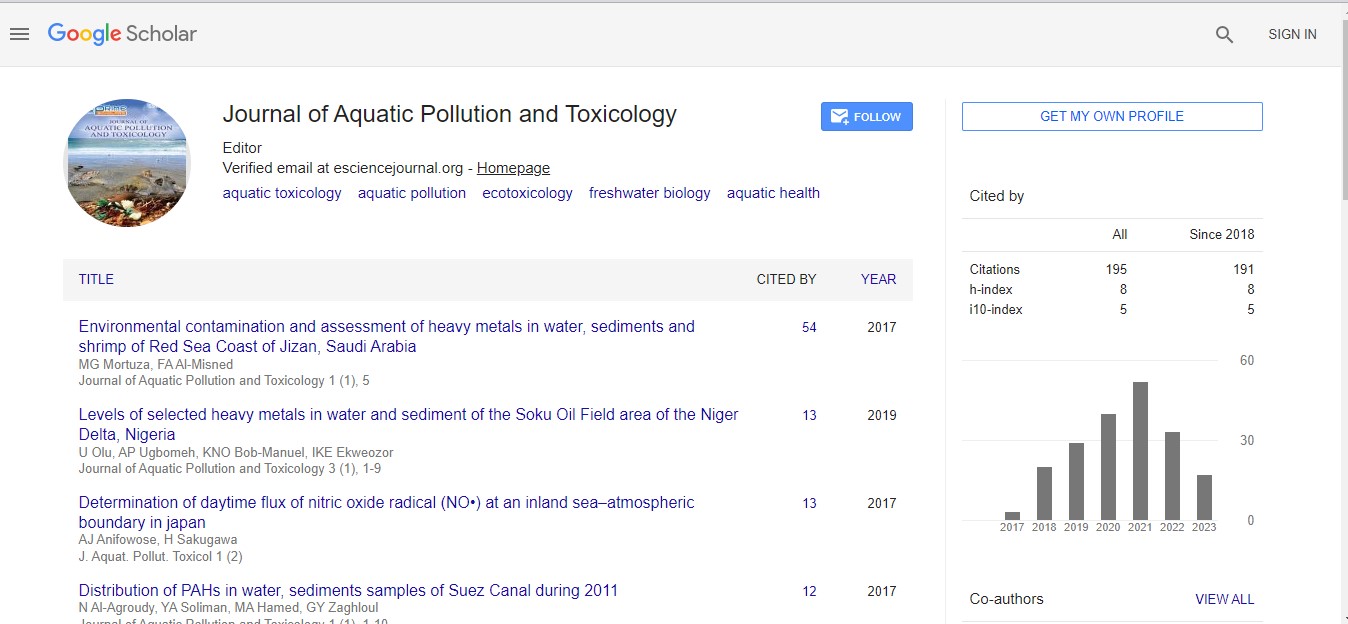Short Communication - (2024) Volume 8, Issue 2
Exploring the Depths: The Fascinating World of Aquatic Environments
Kaito Tanaka*
Department of Aquatic Science, Kyoto University, Japan
*Correspondence:
Kaito Tanaka,
Department of Aquatic Science, Kyoto University,
Japan,
Email:
Received: 29-May-2024, Manuscript No. IPJAPT-24-20013;
Editor assigned: 31-May-2024, Pre QC No. IPJAPT-24-20013 (PQ);
Reviewed: 14-Jun-2024, QC No. IPJAPT-24-20013;
Revised: 19-Jun-2024, Manuscript No. IPJAPT-24-20013 (R);
Published:
26-Jun-2024, DOI: 10.21767/2581-804X-8.2.11
Introduction
Beneath the shimmering surface of Earth’s oceans, lakes,
and rivers lies a realm teeming with life and mystery. Aquatic
environments, encompassing both freshwater and marine
ecosystems, comprise a vast and diverse domain that plays a
crucial role in sustaining life on our planet. From the depths
of the ocean trenches to the tranquil waters of inland lakes,
the aquatic world offers a wealth of wonders waiting to be
discovered. At the heart of aquatic ecosystems lies water, the
elixir of life that sustains a staggering array of organisms. Unlike
terrestrial environments, where access to water may be limited,
aquatic habitats provide a continuous supply of this precious
resource, fostering the evolution of unique adaptations and
ecological niches. From microscopic plankton to massive
whales, aquatic life forms span a remarkable spectrum of sizes,
shapes, and behaviours, each intricately woven into the fabric
of their watery homes.
Description
Marine environments, covering more than two-thirds of the
Earth’s surface, harbour some of the planet’s most awe-inspiring
ecosystems. Coral reefs, often referred to as the “rainforests of
the sea,” support a dazzling array of marine life, from vibrant
fish to intricate coral polyps. These underwater oases serve as
breeding grounds, nurseries, and feeding grounds for countless
species, making them vital hubs of biodiversity and ecological
productivity. In the vast expanse of the open ocean, pelagic
species roam the deep blue, from graceful sharks and majestic
whales to sleek dolphins and elusive squid. These nomadic
creatures traverse vast distances in search of food, mates,
and suitable habitat, embodying the spirit of adventure and
resilience in the face of the ever-changing marine environment.
Closer to shore, coastal ecosystems blend the dynamic forces of
land and sea, giving rise to diverse habitats such as mangrove
forests, estuaries, and salt marshes. These transitional zones
support a wealth of life, serving as nurseries for juvenile fish,
nesting sites for migratory birds, and buffers against coastal
erosion and storm surge. Despite their ecological importance,
coastal habitats face growing threats from human activities,
including pollution, habitat destruction, and climate change,
underscoring the need for conservation and sustainable
management efforts. Inland waters, including lakes, rivers,
and wetlands, represent another facet of the aquatic world,
harbouring their own unique assemblages of flora and fauna
[1-4].
Conclusion
Freshwater ecosystems provide essential services such
as drinking water, irrigation, and hydropower, while also
supporting recreational activities such as fishing, boating,
and swimming. However, these invaluable resources are
increasingly under pressure from pollution, overexploitation,
and habitat degradation, highlighting the importance of
conservation initiatives to safeguard their ecological integrity. In
addition to their ecological significance, aquatic environments
hold immense cultural and recreational value for human
societies around the world. From ancient seafaring civilizations
to modern-day beachgoers and anglers, people have long
been drawn to the allure of the ocean and its inhabitants.
Coastal communities rely on marine resources for sustenance,
livelihoods, and cultural practices, forging deep connections to
the sea that endure through generations. As we delve deeper
into the mysteries of aquatic ecosystems, we uncover not
only the intricacies of marine and freshwater life but also the
interconnectedness of all living beings on Earth.
Acknowledgement
None.
Conflict Of Interest
The author declares there is no conflict of interest in publishing
this article.
References
- Becker BE (2009) Aquatic therapy: Scientific foundations and clinical rehabilitation applications. PM R 1(9):859-72.
[Crossref] [Google Scholar] [PubMed]
- Lensink MJ, Li Y, Lequime S (2022) Aquatic flaviviruses. J Virol 96(17):e0043922.
[Crossref] [Google Scholar] [PubMed]
- Roostaei M, Baharlouei H, Azadi H, Fragala-Pinkham MA (2017) Effects of aquatic intervention on gross motor skills in children with cerebral palsy: A systematic review. Phys Occup Ther Pediatr 37(5):496-515.
[Crossref] [Google Scholar] [PubMed]
- Brophy RH, Bernholt DL (2019) Aquatic orthopaedic injuries. J Am Acad Orthop Surg 27(6):191-199.
[Crossref] [Google Scholar] [PubMed]
Citation: Tanaka K (2024) Exploring the Depths: The Fascinating World of Aquatic Environments. J Aquat Pollut Toxicol. 8:11.
Copyright: © 2024 Tanaka K. This is an open-access article distributed under the terms of the Creative Commons Attribution License, which permits unrestricted use, distribution, and reproduction in any medium, provided the original author and source are credited.

